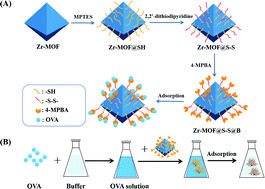Preparation of a boronate affinity-functionalized metal–organic framework material for selective recognition and separation of glycoproteins at physiological pH†
Abstract
Glycoproteins play an important role in biological processes such as protein folding, information transmission, nerve conduction, and molecular recognition. Therefore, designing and developing an adsorbent with high adsorption capacity for glycoproteins are of great importance. In this study, a novel boronate affinity material (Zr-MOF@S-S@B) has been prepared by combining a Zr-MOF, a disulfide covalent bond (–S–S–), and 4-mercaptophenylboronic acid (4-MPBA) for the selective enrichment and elution of glycoproteins at physiological pH. The affinity between boronic acid and cis-diol leads to a high adsorption capacity of 625.5 mg g−1 to the composite material for ovalbumin (OVA). At the same time, Zr-MOF@S-S@B is reusable and has a large specific surface area. Furthermore, the material contains disulfide bonds that can release surface-binding glycoproteins specifically under physiological pH conditions, thus effectively avoiding the reduction of glycoprotein activity. The method is successfully used for the enrichment of OVA in egg white samples and protein powder, which has broad application prospects in the study of glycoproteins.



 Please wait while we load your content...
Please wait while we load your content...